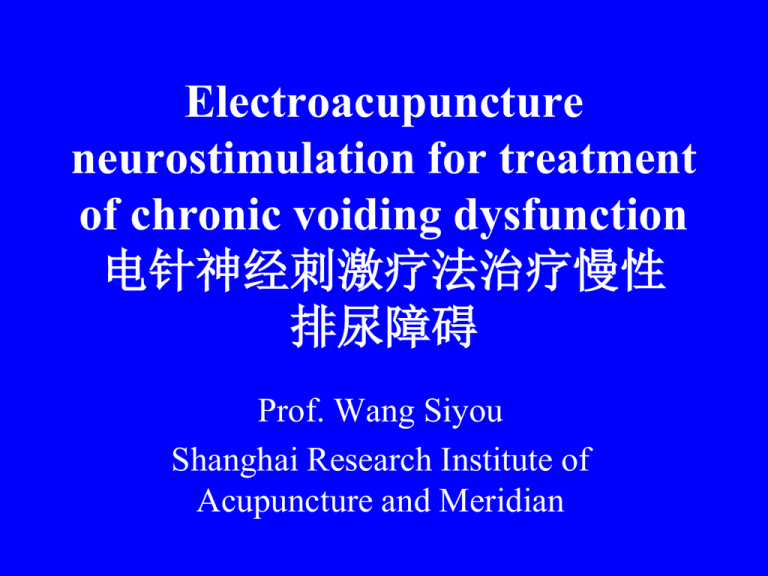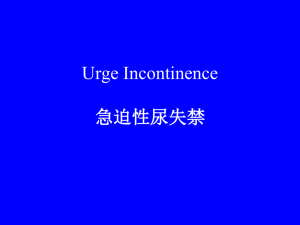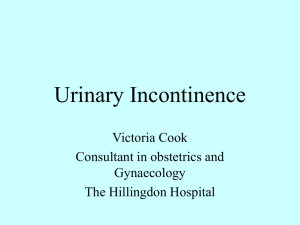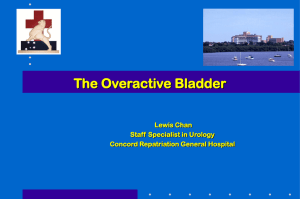
Electroacupuncture
neurostimulation for treatment
of chronic voiding dysfunction
电针神经刺激疗法治疗慢性
排尿障碍
Prof. Wang Siyou
Shanghai Research Institute of
Acupuncture and Meridian
Stress Urinary Incontinence
压力性尿失禁
• Urinary incontinence can be classified
under 7 types in Western medicine
• 尿失禁在西医可分为7种类型。
•
•
•
•
•
•
•
•
Stress urinary incontinence (SUI)
压力性尿失禁
Urge urinary incontinence (UUI)
急迫性尿失禁
Unconscious urinary incontinence
无意识性尿失禁
Continuous urinary incontinence
持续性尿失禁
•
•
•
•
•
•
Nocturnal enuresis
夜间遗尿
Postvoid dribble
排尿后滴尿
Overflow urinary incontinence
充盈性尿失禁
• Stress urinary incontinence (SUI) is defined
as an involuntary leakage of urine from the
urethral meatus at a sudden increase in
intra-abdominal pressure (eg coughing,
sneezing, laughing, running or strenuous
activities) without simultaneous detrusor
contraction.
• 压力性尿失禁是指平时无尿失禁状态下,
当腹压骤增时(如咳嗽、打喷嚏、大笑、
奔跑、剧烈活动)尿液不自主从尿道口
流出,同时不伴有膀胱逼尿肌收缩。
• It often happens in multiparous and
postmenopausal women.
• It comes under the category of enuresis in
TCM.
• 临床多见于中年已生育的妇女。
• 属中医学遗尿范畴。
Stress Urinary Incontinence
Overactive bladder &
Urge incontinence
• Etiology
• The possible causes of stress urinary
incontinence (SUI) are: (1) childbirth and
puerperal injury, and dystocia, especially
forceps delivery; (2) changes in the urethra
and periurethral tissues, eg atrophy of pelvic
floor tissues due to postmenopausal changes
in sex hormones;
• 一. 病因
• 可能的发病原因有:(1)分娩及分娩损伤,
难产、产钳操作尤甚;(2)尿道及尿道周围
组织改变,如绝经后性激素改变致盆底组织萎
缩;
• Etiology
• (3) history of vaginal, urethral or prostatic
surgery; (4) perineal or urethral injury; (5)
pelvic tumescence resulting in a high intraabdominal pressure and a lower position of
bladder neck. More than one cause may
coexist.
• (3)阴道、尿道及前列腺手术史;(4)
会阴部及尿道损伤;(5)盆腔内肿物致
腹压增高,膀胱颈位置降低。一个或多
个病因可同时存在。
• Pathogenesis
• The above etiologies produce the abnormalities of
(vesical neck and urethra) sphincters, that is,
urethral hypermobility or/and intrinsic sphincter
deficiency (intrinsic malfunction of the urethral
sphincter itself) to result in SUI.
• 二. 发病机理
• 上述原因可引起(膀胱颈和尿道)括约肌异常:
尿道活动度增大或/和括约肌内在缺陷(尿道括
约肌本身的内在机能异常,近端尿道失去括约
肌作用),导致压力性尿失禁。
• Pathogenesis
• In the former, a weakness of pelvic floor support
causes the hypermobility and descent of the
vesical neck and proximal urethra during an
increase in intra-abdominal pressure and thereby
unequal transmission of abdominal pressure to the
bladder and urethra (vesicourethral pressure
transmission ratio decreases); when vesical
pressure exceeds urethral pressure, incontinence
ensues .
• 前者是由于盆底支持组织松弛引起膀胱颈部和
近端尿道在腹压增加时活动度增大、向下移位,
导致膀胱尿道压力传递比降低,膀胱内压暂时
高于尿道内压,于是发生尿失禁。
Subtypes of stress incontinence
压力性尿失禁的亚分类
腹压升高
There are 2 possible reasons for urodynamic stress
incontinence:
尿流动力学压力性尿失禁的2个可能原因
• “Hypermobility” “过度移动症 ”
(weakness of bladder support)
(薄弱的膀胱支持力 )
漏尿
• “Intrinsic sphincter deficiency”
“固有括约肌功能障碍”
(“ISD” - weakness of urethral sphincter)
(“ISD”-尿道括约肌力弱)
Video or extra tests (UPP, VLPP) help to make
this distinction
影像技术及其他辅助检查( 尿道压力描计
UPP,屏气时漏尿点压力VLPP)有助于区
分
尿道
无力
Stress Urinary Incontinence
Stress Incontinence: VLPP
Rest & Straining
Simple Tests
• Q Tip Test
– Test for mobility
– >30 degree
• Simple CMG
– Urethral catheter
– Manometer or
– Toomey Syringe
• Clinical manifestations
• 1. Symptom
• Involuntary loss of urine during coughing,
sneezing, laughing, running or physical exertion
such as sport activities and sudden changes of
position.
• 三. 临床表现
• 1. 症状
• 咳嗽、打喷嚏、大笑、奔跑或体育活动、突然
改变体位等身体用力时尿液不自主从尿道口流
出。
• Clinical manifestations
• 2. Signs
• The observation of loss of urine from the urethra
during coughing, sneezing, or physical exertion.
• Positive Marshell (bladder base elevation) test.
• Positive pad test.
• A vaginal examination shows cystocele,
enterocele or rectocele.
• 2. 体征
• 咳嗽、打喷嚏或身体用力时观察到尿液从尿道
口流出。指压(尿道抬举)试验阳性。护垫试
验阳性。阴道检查可见膀胱、肠、直肠膨出。
• Video-urodynamics
• 1. Urethral hypermobility
• The vesical neck is closed at rest (no increase
in intra-abdominal pressure). During stress
(an increase in intra-abdominal pressure), the
vesical neck and proximal urethra open and
descend.
• 四. 影象尿动力检查
• 1. 尿道活动度增大
静止(无腹压增加)时,膀胱颈关闭;应
力(腹压增加)时,膀胱颈和近端尿道开
放和下移。
• Video-urodynamics
• 2. Intrinsic sphincter deficiency
• The vesical neck and proximal urethra are
open at rest in the absence of detrusor
contraction.
• 2. 括约肌内在缺陷
静止、无逼尿肌收缩时,膀胱颈(和近端
尿道)开放。
Hypermobility (type II incontinence)
过度移动症(II型尿失禁)
正常
• Easily defined on
videourodynamics
通过影像尿流动力学很容易确
定
– but Q-tip test or simple observation
will help
但 Q-tip 试验及简单的观察有助于
诊断
Hypermobility
过度移动症
(on cough or Valsalva, or permanent
descent)
(咳嗽,Valsalva,或者持续下降)
LPP measurement
漏尿点压力测量
Strain:
leaks at
165 cm H2O
用力屏气:在
165 cm H2O时
漏尿
(活动过度)
(hypermobility)
• Hypermobility
with
leakage
(on cough)
活动过度
伴漏尿
(在咳嗽
时)
LPP measurement
漏尿点压力测量
Initial pves
初始膀胱压
Strain:
leaks at
45 cm H2O
用力屏气:在
45 cm H2O时
漏尿
Stop fill
at 200 ml
在 200 ml时
停止充盈
Start filling
开始充盈
(no hypermobility,
ISD)
(无过度移动症,固有括
约肌功能障碍)
•
•
•
•
Dagnosis
Based on
The symptom (history) of stress incotinence
Positive stress test (loss of urine during
coughing or physical exertion) and Marshell
test or pad test.
• 五. 诊断
• 根据:
1. 压力性尿失禁症状(病史)。
2. 应力试验阳性(咳嗽或用力腹压增高时有漏
尿)和指压试验阳性或护垫试验阳性。
• Dagnosis
• Based on
• The results of imaging urodynamic
examination: urethral hypermobility or/and
intrinsic sphincter deficiency ; no involuntary
detrusor contraction.
• 3. 影象尿动力检查结果:尿道活动度增大
或/和括约肌内在缺陷;无逼尿肌无抑制性
收缩。
• Treatment
• 1. Western conservative treatment
• Conservative treatment can be applied to
mild and moderate SUI.
• Its advantages are safety, micro invasion,
and much lower incidence and less severity
of complications compared with surgical
treatment.
• 六. 治疗方法
• 1. 西医保守治疗
• 对于轻、中度压力性尿失禁可采用保守
治疗,其优点是安全微创,并发症的发
生率和严重程度远低于手术治疗。
• 1. Western conservative treatment
• Conservative treatment mainly includes
pelvic floor muscle exercises (PFME),
electrical stimulation (ES), various vaginal
and urethral devices and medication.
• PFME and transvaginal or trans-anal ES
(TES) are the two most commonly used
forms of conservative treatment for SUI.
• 保守治疗主要包括盆底肌锻炼、电刺激、
各种阴道和尿道装置及药物治疗。其中
盆底肌锻炼和经阴道或肛门电刺激(被
动的盆底肌锻炼)是最常用的二种治疗
方法。
• 1. Western conservative treatment
• PFME can build up the structural support of
the pelvis, improve neuromuscular function,
prevent the proximal urethra and bladder
base from descending during a rise in
abdominal pressure and increase urethral
pressure.
• 盆底肌锻炼具有增强盆底肌肉支持力量,
改善神经肌肉功能,阻止腹内压增高时
近端尿道和膀胱底部下降及增加尿道压
的作用。
• 1. Western conservative treatment
• Its shortcomings are many patients’
difficulty identifying and isolating their
PFM and inability to perform PFME
effectively; lack of long-term patient
compliance.
• 缺点是:许多患者不能正确收缩盆底肌;
依从性差。
• 1. Western conservative treatment
• TES is passive PFME that produces PFM
contractions and has good patient
compliance.
• Its shortcoming is that it applies vaginal or
anal surface electrode and induces PFM
contractions by indirect nerve stimulation,
so its effect is not as good as that of PFME
which is done correctly.
• 经阴道或肛门电刺激是被动的盆底肌锻
炼,有很好的依从性。缺点是:因使用
表面电极,作用是间接的,效果不及正
确的盆底肌锻炼 。
• 2. Acupuncture treatment
• Acupuncture of traditional Chinese
medicine can also be applied to mild and
moderate stress incontinence. Its advantages
are safety, convenience, and no side effects
and complications.
• 2. 中医针刺治疗
• 对于轻、中度压力性尿失禁也可采用中
医针刺治疗,其优点是安全、方便、无
副作用和并发症。
• 2. Acupuncture treatment
• 1) Therapeutic principle
• According to TCM theory, it is caused by
deficiency of kidney qi and failure of the
bladder in restraining the urine discharge, so
the therapeutic principle is reinforcing
kidney qi and improving vesical restraining
function.
• 1) 治疗原则
• 中医认为,尿失禁是由于肾气不足,膀
胱不固引起,因此治疗原则是补益肾气,
固脬止遗。
• 2) Point selection
• The Back-Shu and Front-Mu points of the
kidney and bladder are selected as the main
acupoints. The acupoints often selected are
Shenshu (B 23), Pangguangshu (B 28),
Zhongji (Ren 3), Guanyuan (Ren 4),
Mingmen (Du 4), Huiyang (B 35),
Sanyinjiao (Sp 6) and Zusanli (S 36).
• 2) 穴位选择
• 主穴是肾和膀胱的背俞穴和募穴。
• 常用穴位有:肾俞,膀胱俞,中极,关
元,命门,会阳,三阴交,足三里。
• 2) Point selection
• The kidney is exteriorly-interiorly related to
the bladder, so the Back-Shu points of the
kidney and bladder are applied. Zhongji
(Ren 3) is the Front-Mu points of the
bladder. The combined use of the above
three acupoints contributes to reinforce
kidney qi and improve vesical restraining
function.
• 肾和膀胱相表里,故选肾和膀胱的背俞
穴。中极是膀胱的募穴。三穴合用有助
于补益肾气,固脬止遗。
• 2) Point selection
• Guanyuan (Ren 4) and Mingmen (Du 4) are
the sources of primordial qi and
acupuncture of them can tonify primordial
yang (kidney-yang). Huiyang (B 35) is the
acupoint of the foot-taiyang meridian and
acupuincture of it can invigorate the
meridional qi of the bladder.
• 关元、命门是元气之源,针之能补肾益
元。会阳是足太阳经穴位,针之能振奋
膀胱之经气。
• 2) Point selection
• Sanyinjiao (Sp 6) is the crossing point of
the three foot-yin meridians and
acupuncture of it can regulate the qi of the
three foot-yin meridians. Zusanli (S 36)
belongs to the yangming meridian, which is
full of qi and blood, and acupuncture of it
can tonify qi to stop incontinence.
• 三阴交是足三阴经交会穴,针之能调节
足三阴经气。足三里属阳明经,阳明经
多气多血,针之能补气止遗。
• 3) Shortcoming
• Because it uses a general method of
acupuncture, it is difficult for conventional
acupuncture, like electrical nerve
stimulation, to improve the ability in
controlling urination by exciting the
pudendal nerve, inducing the rhythmic
contraction of the pelvic floor muscles and
increasing their strength.
• 3) 不足之处
• 因采用一般针刺方法,故难以象神经电刺激疗
法那样通过兴奋阴部神经诱发盆底肌节律性收
缩,增强盆底肌肉力量来改善控尿能力。
• 3. Electroacupuncture pudendal nerve
stimulation
• By combining the advantages of PFME and
TES and incorporating the technique of
deep insertion of long needles, we
developed electracupuncture pudendal
nerve stimulation ( “Four sacral points”
electracupuncture therapy), which is a
combination of traditional Chinese and
Western medicine.
• 3. 电针阴部神经刺激疗法
• 综合PFME 和 TES二种疗法优点,融入针灸长
针深刺技术,我们发展成了(中西医结合的)电
针阴部神经刺激疗法(电针“骶四穴”疗法)。
• 3. Electrical pudendal nerve stimulation
• In this therapy, four sacral specific points
are acupunctured by a special needling
method (the needle tip in a specific
direction) and electrified
• 3. 电针阴部神经刺激疗法
• 该疗法对骶部四个特定穴位采用特殊针
刺方法(针尖向特定方向)并加以电刺
激
• 3. Electrical pudendal nerve stimulation
• to improve the ability in controlling
urination by exciting the pudendal nerve
and inducing the rhythmic contraction of
the pelvic floor muscles (including the
urethral sphincter ) to strength the muscles,
restore the normal positions of bladder neck
and proximal urethra and increase urethral
closure pressure.
• 能直接兴奋阴部神经诱发盆底肌(包括
尿道括约肌)节律性收缩,从而增强盆
底肌肉力量,恢复膀胱颈部和近端尿道
的正常位置,提高尿道关闭压来改善控
尿能力。
• Location of four sacral
points and acupuncture
methods
• 1) The two upper points:
located by the two
edges of the sacrum on
a level with the fourth
sacral foramina;
• 定位和针刺方法
• 1)上两针刺点:骶骨
边缘旁,平第4骶后孔
水平处(双侧)。
Four sacral points
骶四穴
• Location of four sacral
points and acupuncture
methods
• 1) The two upper points:
use a long needle of 4
cun (100mm); puncture
perpendicularly 3~3.5
cun in depth; make the
needling sensation reach
the urethra or anus.
• 使用4寸长针直刺,针
刺深度为3-3.5寸,使
针感达尿道或肛门。
Four sacral points
骶四穴
• Location of four sacral
points and acupuncture
methods
• 2) The two lower points:
0.5 cun bilateral to the
tip of the coccyx; use a
long needle of 4 or 5
cun (100 or 125mm);
• 2)下两针刺点:
• 尾骨旁开0.5寸(双
侧),使用4寸或5寸
长针,
Four sacral points
骶四穴
• Location of four sacral
points and acupuncture
methods
• 2) The two lower points:
puncture obliquely
(laterally) towards the
ischiorectal fossa, 3~4.5
cun in depth; make the
needling sensation reach
the urethra.
• 向外侧(坐骨直肠窝)
斜刺,3-4.5寸深,使
针感达尿道。
Four sacral points
骶四穴
• Electrical pudendal nerve stimulation
• After the needling sensation referred to the above
regions was produced, a G6805-2 Multi-Purpose
Health Device was connected with the inserted
needles used as electrodes. The device was set to
produce an electrical stimulation at a frequency of
2.5 Hz (150 times/min) and an intensity as high as
the patient could tolerate without discomfort. The
electroacupuncture was set for 60 minutes each
time.
• 3. 电针阴部神经刺激疗法
• 针感达特定部位后接G6805Ⅱ治疗仪。电针采
用连续波,频率约2.5Hz (150次/分),强刺激
以患者不感到难受为度,每次持续60分钟。
• Electrical pudendal nerve stimulation
• Strong rhythmic and cephalad contraction of the
pelvic floor muscles around the urethra must be
kept during the electroacupuncture.
• The treatment was given once every other day.
The treatment course was based on the patient’s
condition.
• 电针期间需保持盆底肌以尿道为中心有节律地
向上(头部方向)强烈收缩的感觉。
• 治疗隔日1次,治疗次数视病情而定。
会阴超声、阴道压力同步检测
Accessories
Pressure Measurement
EMG Electrodes
1. DPT Pressure Transducer
1. Disposable Surface
With extension line & flushing syringe
2. Disposable Anal and Vaginal
2. Abdominal Catheter
3. Reusable Anal Sphincter
a. Opened end - F8
b. Balloon
With Abdominal catheter insertion lumen
2b
2a
1
1
3
2
视频盆骶肌生物反馈2#2
0
恢复电刺激
20
停止电刺激
cmH2O
26
特定感应存在
Pabd
40
EMG
uV
29
30
20
10
0
Evt
00:03
2s
00:07
Evt
00:11
00:15
Evt
00:19
00:23
00:27
视频盆骶肌生物反馈2#2
20
0
26
恢复电刺激
cmH2O
停止电刺激
Pabd
40
EMG
uV
30
20
8
10
0
Evt
2s
00:08
00:12
00:16
Evt
00:20
00:24
00:28
00:32
视 频 盆 骶 肌 生 物 反 馈 2#5
20
25
恢复原电刺激强度
cm H2O
减弱电刺激强度
Pabd
特定感应存在
30
10
0
80
EMG
uV
60
40
40
20
0
ST
CV
Evt
00:00
3s
Evt
00:06
Evt
00:12
00:18
00:24
视频盆骶肌生物反馈2#5
20
26
10
恢复原电刺激强度
cmH2O
减弱电刺激强度
Pabd
特定感应存在
30
0
80
EMG
uV
60
40
20
8
0
ST Evt
CV
3s
00:00
Evt
00:06
00:12
Evt
00:18
SP
00:24
00:30
00:36
视频盆骶肌生物反馈2#4
37
20
恢复特定针感
40
无特定针感
cmH2O
特定针感
Pabd
0
80
EMG
uV
60
40
25
20
0
ST Evt
CV
3s
00:00
Evt
00:06
00:12
Evt
00:18
00:24
00:30
视频盆骶肌生物反馈2#4
40
20
36
恢复特定针感
cmH2O
无特定针感
Pabd
0
80
EMG
uV
60
40
20
15
0
Evt
3s
00:04
00:10
00:16
Evt
00:22
00:28
00:34








